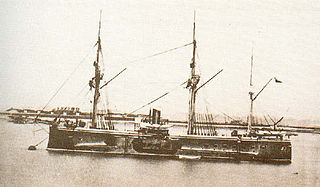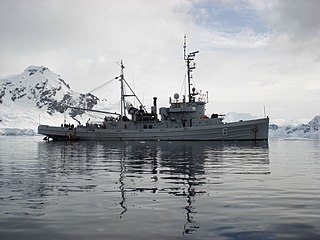
The Peruvian Navy is the branch of the Peruvian Armed Forces tasked with surveillance, patrol and defense on lakes, rivers and the Pacific Ocean up to 200 nautical miles from the Peruvian littoral. Additional missions include assistance in safeguarding internal security, conducting disaster relief operations and participating in international peacekeeping operations.

In late 19th-century naval terminology, torpedo gunboats were a form of gunboat armed with torpedoes and designed for hunting and destroying smaller torpedo boats. By the end of the 1890s torpedo gunboats were superseded by their more successful contemporaries, the torpedo boat destroyers.

USS Luiseno (ATF-156) was an Abnaki-class fleet ocean tug built for the United States Navy during World War II. Named after the Luiseño peoples, she was the only U.S. Naval vessel to bear the name.
USS Arapaho (AT-68/ATF-68) was a Navajo-class fleet ocean tug which served the U.S. Navy during World War II with her towing services. She was assigned initially to support the U.S. Atlantic Fleet, and was eventually assigned to support Allied forces in the war zones of the Pacific Ocean, resulting in her crew returning home after the war with four battle stars to their credit.

Blanco Encalada was a central battery ship built by Earle's Shipbuilding Co. in England for the Chilean Navy in 1875. She was nicknamed El Blanco. She participated actively in the War of the Pacific, her most important action being the capture of the Peruvian monitor Huáscar during the Battle of Angamos.
An Empire ship is a merchant ship that was given a name beginning with "Empire" in the service of the Government of the United Kingdom during and after World War II. Most were used by the Ministry of War Transport (MoWT), which owned them and contracted their operation to various shipping companies of the British Merchant Navy.

ARA Suboficial Castillo (A-6) was an Abnaki-class tug/patrol boat of the Argentine Navy. She previously served in the United States Navy as USS Takelma (ATF-113) from 1944 to 1992. The ship was acquired by Argentina in 1993 and was in service until the 2020s. In 2022, the ship was put up for sale. Suboficial Castillo was used as support ship for both the Argentine Submarine Force and during the summer campaigns in Antarctica in the Patrulla Antártica Naval Combinada with the Chilean Navy to guarantee safety to all touristic and scientific ships that are in transit within the Antarctic Peninsula.
Several ships of the Chilean Navy have been named Lautaro after Lautaro, a Mapuche leader during the War of Arauco.
The Quidora was one of four torpedo boats built in Spain for the Chilean Navy since 1962, based originally in the Jaguar-class fast attack craft FPB-36 design of the German Lürssen Werft. Her sister ship Fresia PTF-81 is now a museum ship in Punta Arenas.

The introduction of fast torpedo boats in the late 19th century was a serious concern to navies of an era that saw a number of innovations in naval warfare, including the first torpedo boats, which carried spar torpedoes, steam propulsion and steel ships.

On 15 October 1965 the Chilean Abnaki-class tug Janequeo sank off Caleta Llico, 60 nautical miles south of Corral, Chile, with the loss of 51 men.

The Chilean tugboat Janequeo (ATF-65) was an Abnaki-class tug of the Chilean Navy that sunk on 15 August 1965 during a devastating storm in the Bay of Manquemapu, 60 nautical miles south of Corral, Chile with the loss of 51 men as she helped Leucotón that had run aground.
Colo Colo was a Colo Colo-class torpedo boat built for the Chilean Navy in 1880. The torpedo boat participated in the War of the Pacific, where it fought in the blockade of Callao and patrolled Lake Titicaca in the final phase of that war.

The Guacolda was a torpedo boat bought by Peru at the beginning of the War of the Pacific, but captured by the Chilean Navy in the Ecuadorian port of Ballenita before being commissioned.

The Raids of the Huáscar were a series of raids that occurred by the Peruvian ironclad Huáscar under the command of Miguel Grau Seminario during the War of the Pacific. The actions kept the Chilean government in check for nearly five months which ended after the Battle of Angamos.
This page is based on this
Wikipedia article Text is available under the
CC BY-SA 4.0 license; additional terms may apply.
Images, videos and audio are available under their respective licenses.









